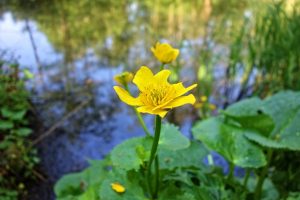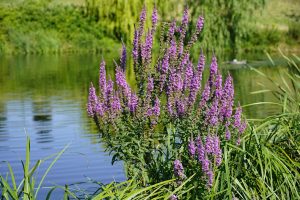Last Updated on April 12, 2024 by Real Men Sow
Water is a great addition to any garden. There are many aquatic plants that can thrive in a water pond. Oxygenating plants for ponds are not only attractive but also provide shelter and cover for aquatic wildlife. The water can be kept clear by using oxygenating plants.
You can grow pond plants in a sand-based nutrient mix, with grit added. Choose plants that will fit the space available. Planting depths vary from one species to the next. Some plants require 2.5 cm of water above their crowns, while others require 30 cm or more.
What’s the Difference Between Oxygenating Plants For Ponds or Marginal Plants?
Pond plants: Marginal plants
Marginals can be found in shallow water and damp soil near pond edges. For healthy pond life, they are as important as oxygenating plants. The native flowering margins of the pond are great for attracting flying insects and their leaves will provide shelter for aquatic wildlife as well as habitat for them to lay eggs.
Marginals are important for protecting pond edges. However, they can also be used to guide you in designing your planting plan. Consider your pond as a border. Think about how the plants will interact with each other, such as in a colour scheme or textural contrasts. Marginals are not only for wildlife ponds but they can also be used to add height and contrast to formal ponds.
 Caltha palustris
Caltha palustris
Caltha palustris is a beautiful pond plant. It has bright glossy leaves and yellow buttercup-like flowers that grow on tall stems in the late spring and early Summer to attract pollinating insects. The marsh marigold is an excellent plant for a shaded pond. It can be found along streams, in shallow water around ponds and ditches, as well as in shallower water. This plant is strong and clump-forming. It should be planted in baskets near the edge of any pond.
Butomus umbellatus
Butomus umbellatus is a beautiful marginal plant that bears attractive flowers measuring up to 3cm in diameter. These attract butterflies and hoverflies because of its umbel of pink flowers which are arranged on tall stems above the twisted, grassy leaves. This flowering rush needs plenty of space. It will not bloom well if it is too dense.
Carex elata ‘Aurea’
Carex elata “Aurea” is a strong, long-lasting sedge that can be grown in boggy areas around pond edges. Its bright yellow-green leaves will soften the edges of the water and reflect in it. It is also a good choice for border plants with heavy soil. Allow it to grow to the desired size, then divide as necessary. It thrives in shade but can tolerate the sun.
 Iris pseudacorus
Iris pseudacorus
The yellow flag iris is an excellent choice for large sunny ponds. These iris flowers, which appear in late spring, are distinguished by their distinctive sword-shaped leaves. The bright yellow flowers are often elegant and are usually beautiful. This plant makes a stunning display when it is planted in large numbers or naturalized among other marginals. After the plant has flowered, it should be divided every 2 years.
Cyperus papyrus
The Egyptian paper rush can be a delicate marginal plant. So plant it in a pot and let it rest in water until you are ready to move it to a protected spot in the winter. If you are looking to add architectural or exotic foliage to your pond, it’s well worth the effort. It stands out from other natural plants because of its tall, bright-green stems and tufted umbels.
Houttuynia cordata ‘Chameleon’
The chameleon is an unusual looking plant. People either love it or find it a little strange. It is low-growing, provides good cover around the pond’s edges, and has small white flowers and fetching red, green, and cream variegated foliage. It can grow in shade.
 Lythrum salicaria
Lythrum salicaria
The purple loosestrife, a native wildflower that adds height and beauty to bog gardens as well as the edges of ponds. Lythrum salicaria’s purple, nectar-rich blooms attract butterflies and bees, as well as bringing colour throughout summer and autumn. Divide every two years.
Orontium aquaticum
This marginal aquatic grows unusual yellow flower spikes in the early summer when it is planted in a sunny location. The golden club adds vertical interest to any pond and is a fascinating addition.
Pontederia cordata
Pickerelweed is a great way to inject some color into your pond planting plans. The sword-shaped leaves provide a backdrop for masses of bright purple flowers that attract pollinating bugs in late summer.
Oxygenating Plants For Ponds
For a healthy garden pond, oxygenating plants are essential. They are primarily found underwater and produce oxygen as well as absorbing impurities. This helps keep the pond clean and clear. They compete with unwanted algae to obtain nutrients, which helps limit their spread.
Submerged plants are able to produce oxygen during daylight hours and provide shelter for aquatic life such as newts or frogs. Some oxygenators can be partially submerged, allowing them to perform dual functions. This increases oxygen levels in the water. Meanwhile, leaves and stems that are above the water level provide shade, protection, and food for wildlife.
Native plants are more resilient to cold and ice during winter months. If they do escape from your garden pond, they won’t cause any disruption to the natural waterways. If your pond is sufficiently large, it’s a good idea for you to have a mixture of oxygenators or consider a pond heater. If necessary, plants can be trimmed in spring.
Ceratophyllum demersum
Hornwort, a common British native, is an oxygenating plant that lives in permanent submerged water. It is best suited for a still-water pond, in partial or full sun. The dark green, feathery leaves float in the water and grow loosely. In summer, they can be thinned by leaving the dark-coloured stems alone and removing only the clear or yellow ones.
Fontinalis antipyretica
Water moss is a British native oxygenating plant that grows deep below the water surface. It can grow in either sun or shade thanks to its dark green, branched stems. This oxygenating plant can spread easily by being removed by hand.
Hottonia palustris
Water moss is a British native oxygenating plant that grows deep below the water surface. It can grow in either sun or shade thanks to its dark green, branched stems. It can spread easily by being removed by hand.
Isolepis cernua
An annual that is evergreen, Isolepis Cernua is a marginal aquatic plant that will help oxygenate water. It can also be grown in bog gardens or container ponds. Summer brings out the cream-white flowers on the grassy leaves. Shade is where the club rush and the slender club rush can grow.
Myriophyllum spicatum
The British native oxygenating plant for ponds, spiked water milfoil, has submerged olive-green feathery leaves. Between May and August, small yellow and red flowers appear above the water surface. It can be used in any sized pond as long as it is at least 30cm deep and no more than 90cm. It is easy to confuse it with non-native milfoils.
Potamogeton crispus
This submerged British native oxygenating plant has olive green, somewhat seaweed-like leaves. In early summer, curled pondweed will produce small pinkish flowers that rise to the surface. It can grow in both shaded and sunny ponds, and it spreads easily. It can be added to a pond as a new addition. Then, fill it up to one-third of the way. You can then trim older stems to maintain control.
Ranunculus aquatilis
This oxygenator is native to Britain and is mostly submerged. Some foliage may appear on the surface, while white flowers bloom in May. The hoverflies, bees, and butterflies will love water crowfoot. It can tolerate all water conditions, including rivers and streams. It generally doesn’t require maintenance.

